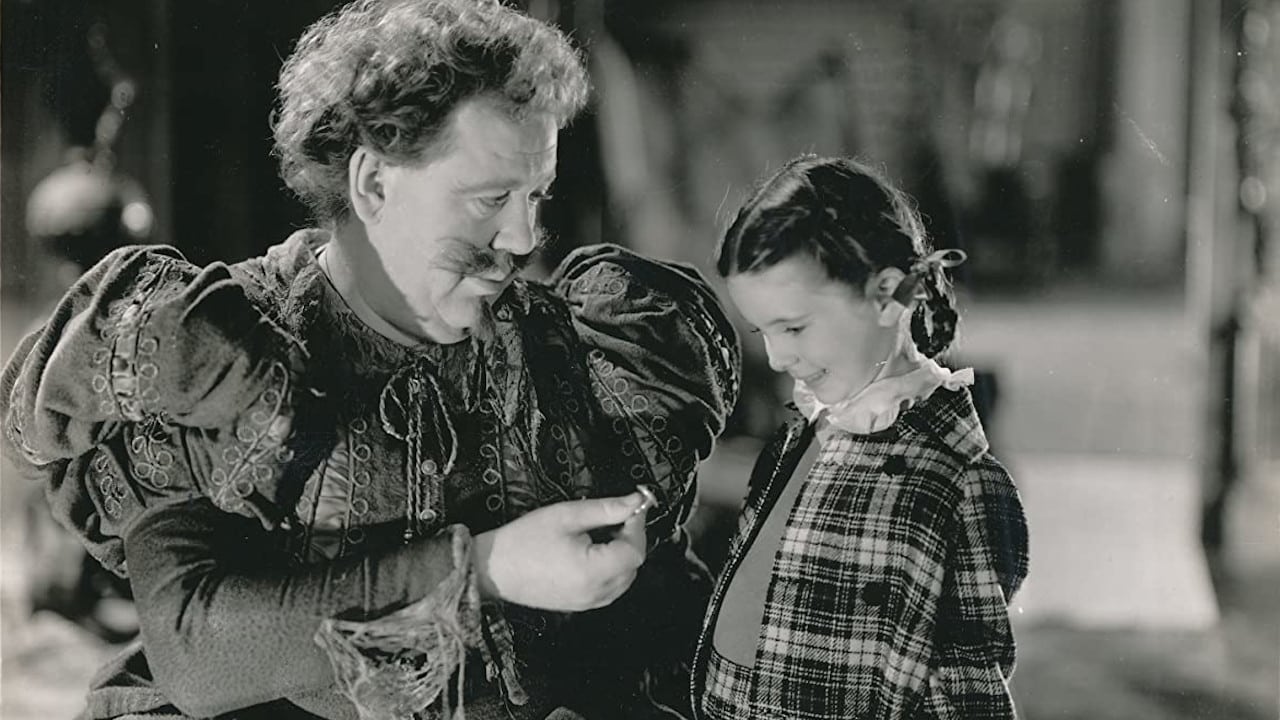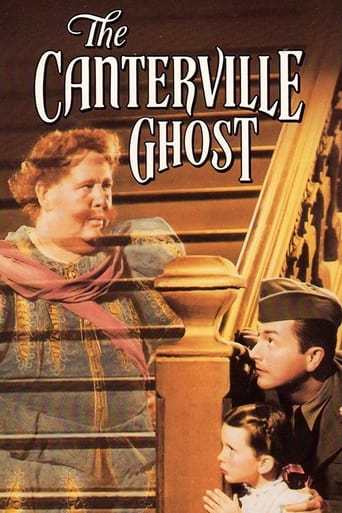

Oscar Wilde would be hard put to recognize his off-spring in this updated film ver¬sion. Not only have his American tenants been replaced by billeted G.I.'s and his her¬oine's age lowered from fifteen to six, but the character of the ghost himself has under¬gone a remarkable transformation. No longer a bully who murdered his wife because "she was very plain, never had my ruffs properly starched, and knew nothing about cookery", he is a sadly penitent creature obviously modeled on Robert Donat's The Ghost Goes West for motivation and Bert Lahr's Cowardly Lion for character. At least his speech about death is still more or less intact: "Death must be so beautiful. To lie in the soft brown earth, with the grasses waving above one's head, and listen to silence. To have no yester¬day, and no tomorrow. To forget time, to for¬give life, to be at peace." Naturally, all the quips and satiric thrusts Wilde directed at Americans have been ruth¬lessly removed, e.g. "I come from a modern country, where we have everything that money can buy... I reckon if there were such a thing as a ghost in Europe, we'd have it at home in a very short time in one of our public museums, or on the road as a show." (This Wilde idea was actually used in The Ghost Goes West). MGM have fashioned Wilde's wit into a rather ponderous and hokey script. Nonethe¬less, it does offer some marvelously comic and wonderfully bizarre opportunities for Laughton who takes full advantage of every opening. Miss O'Brien proves a gifted assistant, but - with the exceptions of Reginald Owen and Una O'Connor - the rest of the players are somewhat hamstrung by forced and dated dialogue. No matter, as Charles Higham points out in his incisive study, "Charles Laughton: An Intimate Biography" (Doubleday, New York, 1976) Laughton is always most engaging. Whether "flying across rooms rattling his chains, screaming or groaning to frighten the G.I.'s, or, in a lyrical sequence, quietly speaking about his need for peace ... he makes the ghostly Canterville a touching and pleasantly grotesque figure of fun." Charles Higham also tells us that the film was started by director Norman Z. McLeod who relinquished his post in despair after seven days of shooting when he failed to win Laughton's confidence. Laughton helped the young Dassin with valuable suggestions in private, though taking pains never to argue with the director in front of the cast and crew.All told, Dassin's direction comes across as proficiently competent, though there is little to distinguish his input from that of the other minor MGM directors of this period - like Roy Rowland, say - except a couple of unusually long takes between Laughton and O'Brien, and a few shots stylishly framed by mullioned windows. Robert Planck's black-and-white photography tends to be grainy (to facilitate the special effects?), though some of the night interiors are very attractively lit (the television print is tinted green, or at least it was back in 1987. The current print aired by TCM has reverted to grainy black-and-white). Other credits are up to the mark.
... View MoreThis is a most accomplished movie and haunting. From the first moments of bricking in to the final absolution of the ghost it follows a poetic course and is one of the greatest of redemption movies. But it's not available as DVD in UK and I doubt it's been shown on UK TV in the last 30 years. Is there a copyright problem with it? One would have thought not. Have the producers of the later movie buried it? Surely not. Charles Laughton's role here is deeply affecting - and given knowledge of his homosexuality, the portrayal of the failed knight unable to compete in the jousts and ostracised by his community and family becomes even more affecting. His equivalent is the poor lion in the Wizard of Oz.His redemption comes of course with the arrival of the unflappable American family and especially their loving daughter who sees qualities in the poor knight that were never seen before. This is a lovely film that needs to be seen more often.
... View MoreI don't know that I will even give a movie a 10 out of 10, but this movie has "haunted" (in a wonderful way) my life since my childhood! Not only do the great actors of those days and the screen writing teach us what real life, courtesy, care, concern and speech are like, they can still flood our minds with hope! Not to say that good movies aren't still made, because they are! And not say that everyone was rosy and good then, either. But this movie still retains a way, and tugs on our minds and hearts, to still be good people, to not give in to the epithets of the present U.S. culture of 2007. It only takes honesty, care, understanding, concern and kindred souls to realize that we all are one on this planet, and may more planets than just this one. And actors such as Charles Laughton, Margaret O'Brien, Robert Young, Rags Ragland, Una O'Connor, Reginald Owen, and so many more, continue to teach us in ways that many of our present day actors will never be able to. And I'm not sure why!?! And isn't it interesting that 2 GIs can dance together, and do it wonderfully well, and it IS art!! And yet done today, people would look at all of that and make lurid judgments!! And a 7 year old could act with the likes of a Charles Laughton and we don't jump to all kinds of disreputable conclusions, at might happen today. I am thankful for movies and stories such as this. I am thankful for people such as Oscar Wilde, Edmin Blum and Jules Dassin. Unfortunately, the telling of the realities of war, though, although not as graphic then as now, (maybe that's not a bad thing), are still as haunting today as back then. But rather than end on a sad note, I say, let us all raise a glass to the hope that is part of the movies of such as the like as Charles Laughton, and to the hope that will continue in many ways in today's movies. I know they are there. I watch too many not to understand that. It's just that times were different. But people usually still fight for good and noble causes today as ever before, and isn't that what this movie is about?!!!
... View MoreThis review is somewhat biased, as I am an avid Robert Young fan, and have yet to see him in a less than stellar performance. Margaret O'Brien is also splendid, and it is hard to believe so much talent projects out of a six year old girl. Charles Laughton is memorable in his fine delivery of both pathos and comedic skills.A highlight of the film for me is the music played by the G.I.s. at a local party. Music is classic 40's 8 to the bar, visually punctuated with awesome jitterbugging by the soldiers. A proper female British spectator comments to an incredulous priest, "I believe they call it woogie boogie." It is unknown what what the song title or who the recording artists may have been, however credits list original music for the film as provided by George Bassman.
... View More